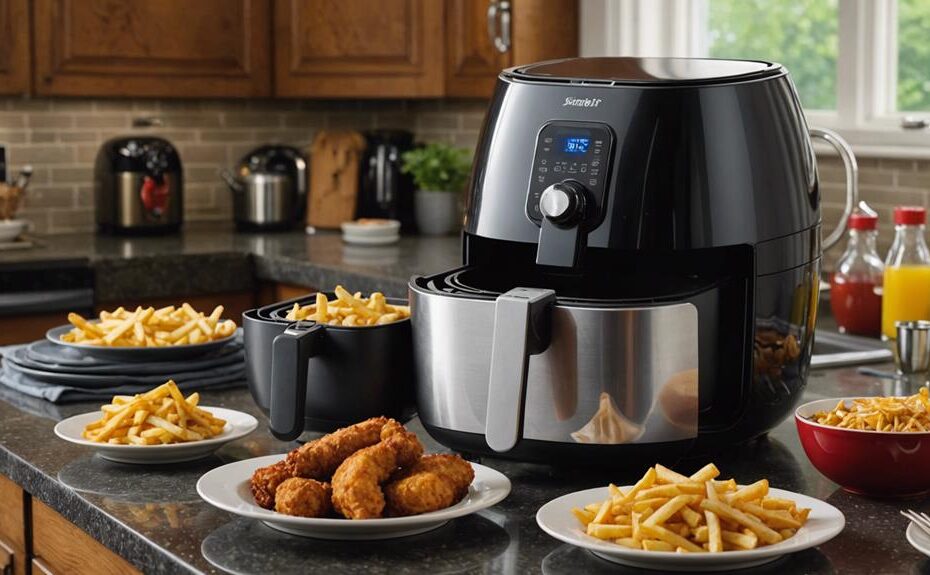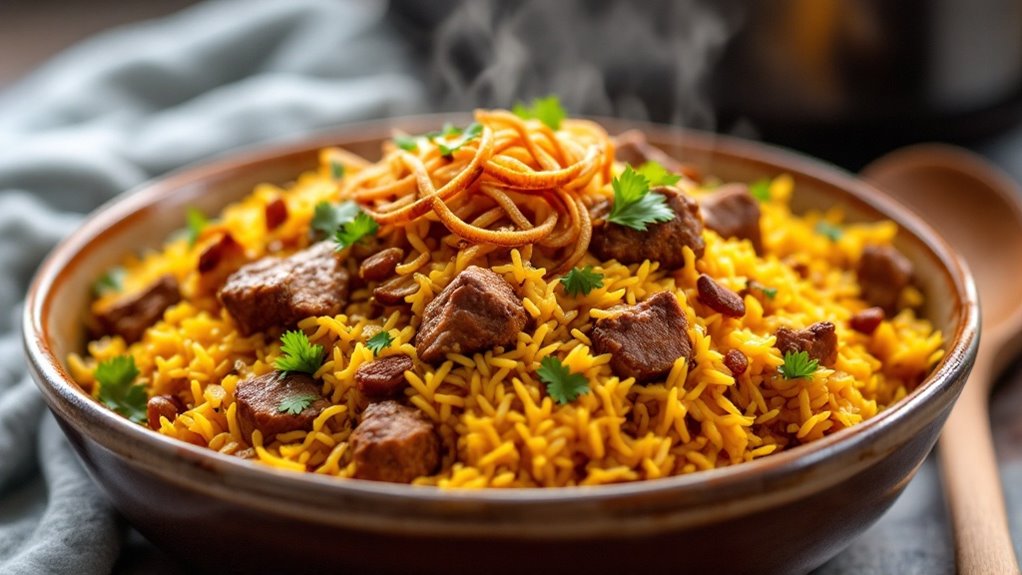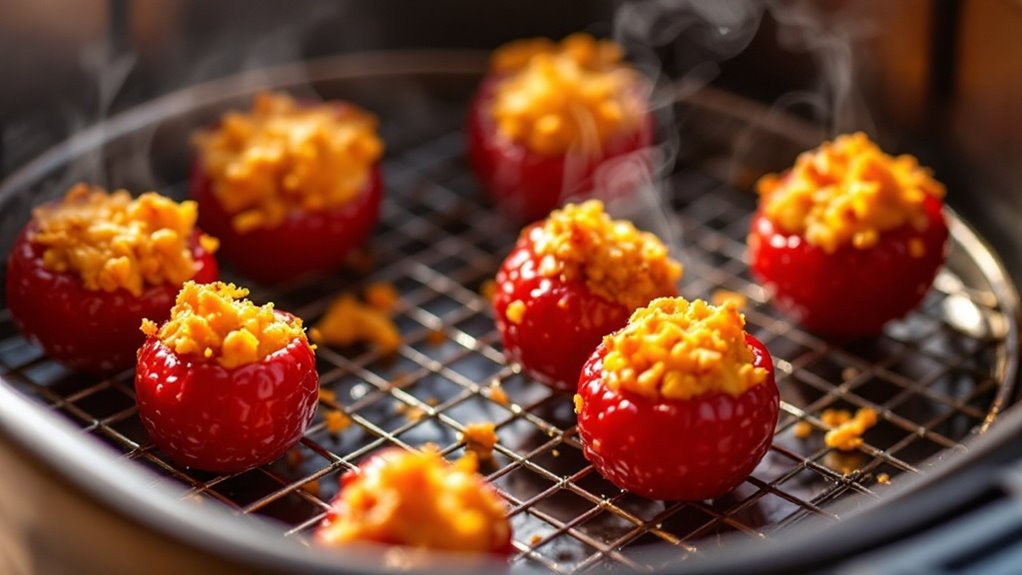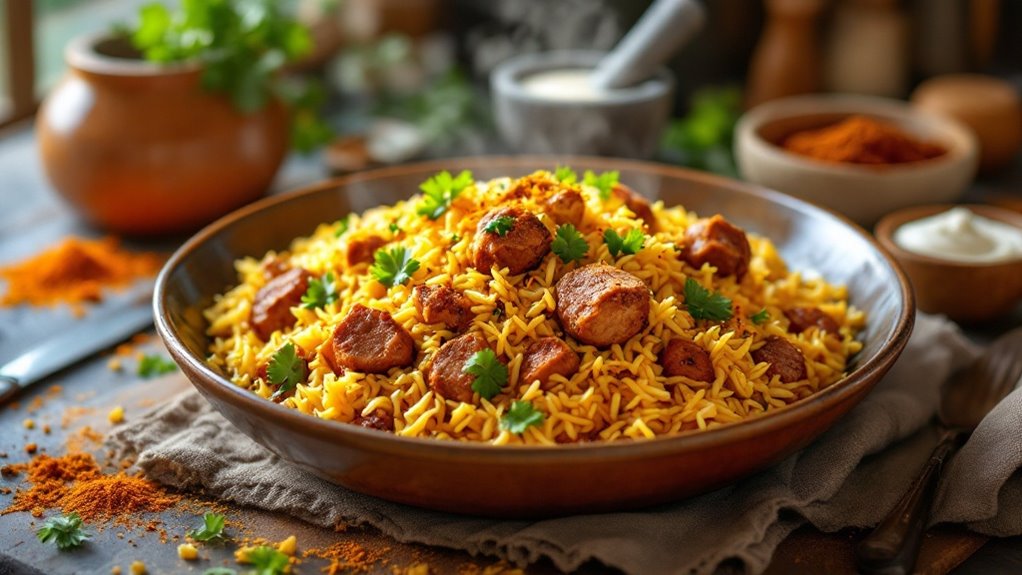Air fryers have several drawbacks. You might find the cooking capacity too small for larger meals, necessitating sequential cooking. High temperatures can degrade heat-sensitive nutrients, and acrylamide formation is a concern despite being lower than deep frying. Taste and texture differences due to less oil usage can also be less satisfying. These devices often burn food quickly if not monitored closely, and they tend to be noisy. Lastly, there's a steep learning curve for mastering precise cooking times and temperatures. Understanding these aspects will help you decide if an air fryer suits your culinary needs.
Key Takeaways
- Limited cooking capacity makes it difficult to prepare larger meals or multiple dishes simultaneously.
- High cooking temperatures can degrade heat-sensitive nutrients, requiring careful monitoring of cooking times and temperatures.
- Achieving desired taste and texture, like deep-fried crunchiness, can be challenging due to reduced oil usage.
- Rapid air circulation increases the risk of burning food if not closely monitored, posing a steep learning curve for beginners.
- Noticeable noise from the fan can be disruptive, especially in quiet environments, affecting the overall cooking experience.
Limited Cooking Capacity
Given their smaller cooking capacities compared to traditional ovens, air fryers often limit the amount of food you can prepare at one time. This limited cooking capacity becomes particularly problematic when you're cooking for larger meals or gatherings. The need to prepare food in multiple batches can be both time-consuming and inconvenient. For example, if you're hosting a dinner for several people, the smaller cooking capacities of air fryers necessitate sequential cooking, which extends your overall preparation time to a great extent.
Additionally, adjusting recipes for these smaller cooking spaces requires meticulous planning. Traditional recipes designed for larger ovens may not translate well to an air fryer, necessitating alterations to ingredient quantities and cooking times. This can be an added layer of complexity and effort that you might not have anticipated.
Furthermore, the restriction in cooking multiple dishes simultaneously is another drawback. Unlike larger kitchen appliances that allow for multi-dish cooking, air fryers constrain you to one dish at a time. This limitation is particularly challenging for those who are used to the flexibility offered by traditional ovens. Hence, the limited cooking capacity of air fryers is a significant drawback that can impact meal preparation efficiency and convenience.
Potential Nutrient Loss
High cooking temperatures in air fryers can compromise the nutritional integrity of food by degrading heat-sensitive vitamins and antioxidants. When you expose food to high heat, the delicate structure of certain nutrients, such as vitamin C and various antioxidants, can break down. This degradation leads to a significant nutrient loss, which diminishes the health benefits of the food.
Prolonged exposure to high temperatures exacerbates this issue. Overcooking not only affects the texture and taste but also results in a more substantial nutrient loss. Foods left in the air fryer for too long will lose more of their heat-sensitive vitamins and antioxidants, further reducing their nutritional value.
To mitigate these effects, you should carefully monitor cooking times and temperatures. This vigilance is essential for retaining nutritional value. Selecting appropriate cooking settings and ingredients can help minimize nutrient loss. For instance, opting for vegetables that retain more nutrients when cooked at lower temperatures can be beneficial. Additionally, cutting food into smaller pieces can reduce cooking time, thereby limiting the exposure to high heat.
Acrylamide Formation
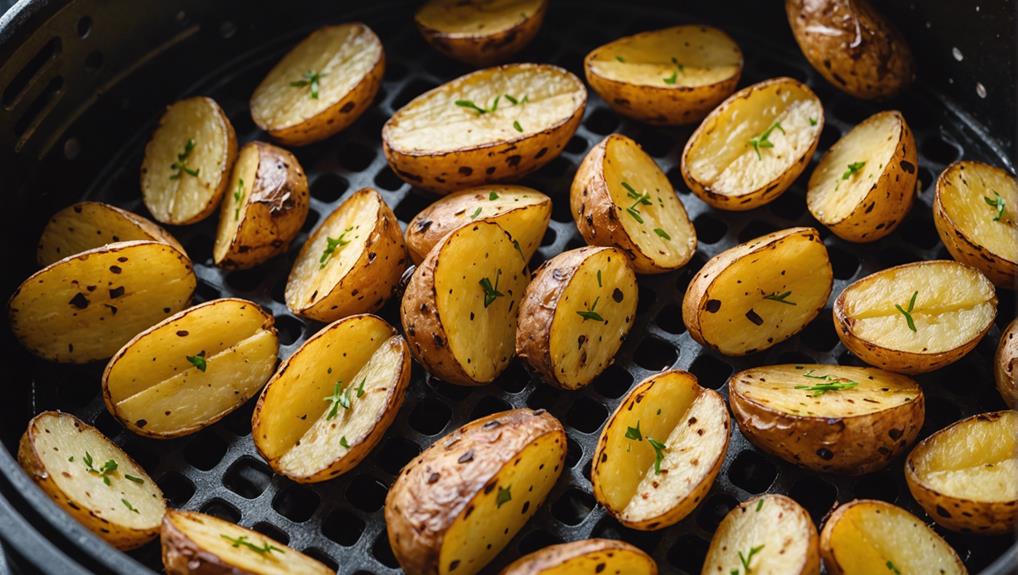
Cooking starchy foods like potatoes in an air fryer can still result in the formation of acrylamide, a potentially harmful chemical compound. Acrylamide forms when foods are cooked at high temperatures, typically above 120°C (248°F). This process occurs in both air-fried and deep-fried foods. While air fryers generally produce lower levels of acrylamide compared to traditional deep frying, they don't eliminate it entirely.
When using high-heat cooking methods like air frying, the risk of acrylamide formation remains. Studies have shown that air fryers can reduce acrylamide formation by up to 90%, but it's still important to exercise caution. To minimize acrylamide in air-fried foods, consider cooking at lower temperatures and for shorter durations whenever possible.
Another way to reduce acrylamide formation is by soaking starchy vegetables like potatoes in water before air frying. This can help lower the precursor compounds that contribute to acrylamide. While air-fried foods may be a healthier alternative to deep-fried foods, it's essential to be aware of the potential for acrylamide and take steps to mitigate its formation. Moderation and mindful cooking practices can help you manage these risks.
Taste and Texture Issues
The taste and texture of air-fried foods often differ from their deep-fried counterparts due to the unique cooking method employed by air fryers. When you use an air fryer, hot air circulates around the food, which can result in a taste that some find less significant compared to deep-fried foods. This difference arises because air frying typically uses little to no oil, impacting the flavor profile.
From a texture standpoint, achieving the same level of crunchiness as deep-fried foods can be challenging. The lack of oil means that the surface of air-fried foods doesn't always develop the same crispy exterior that deep frying can produce. Additionally, you may notice a lack of juiciness in air-fried foods. The hot air circulation method can sometimes dry out the food, leading to a less succulent interior.
Achieving specific textures, such as a perfectly crispy coating, often requires precise adjustments in temperature and timing, which can be difficult to master. Your taste preferences play an essential role in how you perceive these differences. While some may appreciate the healthier taste of air-fried foods, others might miss the rich, indulgent flavors and textures of their deep-fried counterparts.
Risk of Burning Food
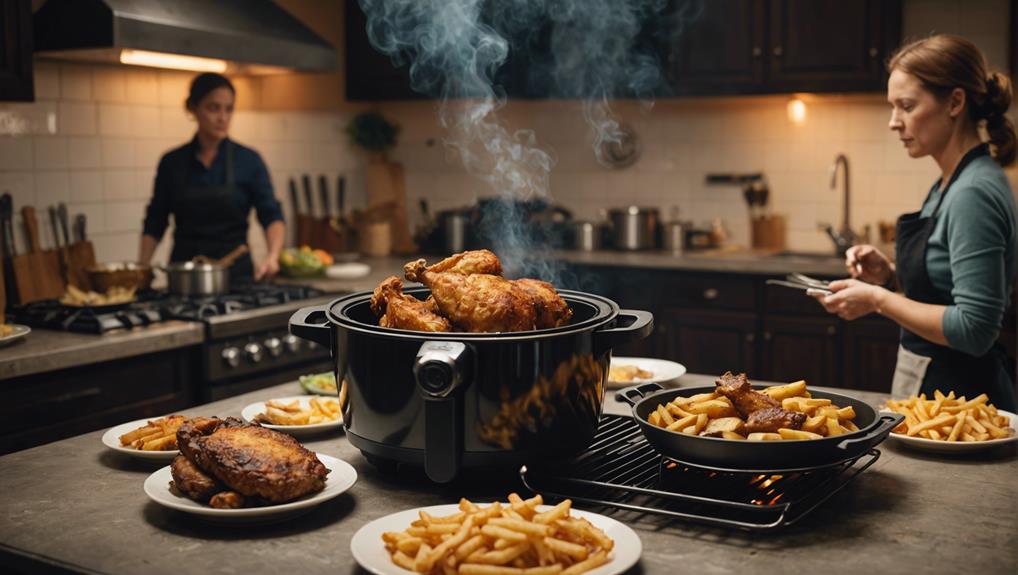
One major drawback of air fryers is their propensity to burn food quickly if not monitored with precision. The quick cooking process facilitated by rapid air circulation can easily lead to food burning. This characteristic makes air fryers a double-edged sword; while they can cook meals swiftly, they also require diligent attention to avoid overcooking.
For beginners, timing is often the most challenging aspect. Unlike conventional ovens, air fryers reach high temperatures rapidly, increasing the risk of burning food. It's important to understand that even a minor lapse in attention can transform a perfectly cooked dish into an overcooked, burnt mess. This steepens the learning curve for those new to air frying, as achieving the desired texture without burning food demands practice and precision.
Moreover, the uniform air circulation, while efficient, can exacerbate the problem. Hot air envelops the food from all angles, making it more susceptible to burning if the cooking duration is not carefully managed. It's vital to frequently check on the food and adjust the timing according to the specific recipe and quantity. Hence, the risk of burning food remains a significant disadvantage, particularly for those unfamiliar with the nuances of this cooking method.
Drying Out Food
Rapid air circulation in air fryers can often result in food drying out, posing a challenge for achieving ideal moisture levels in dishes like chicken breasts or vegetables. The cooking process, characterized by high temperatures and limited oil usage, tends to strip away the natural moisture content. This phenomenon is exacerbated when you overcook food, leading to a dry, unappetizing texture.
Air fryers are designed to replicate the crispiness of deep-fried food but with markedly less oil. While this is beneficial for health-conscious cooking, it can also lead to moisture loss. Foods that naturally contain higher water content, such as vegetables or lean meats, are particularly susceptible to drying out.
Monitoring cooking times and temperatures is essential to mitigate this issue. Using a lower temperature and reducing cooking duration can help retain more moisture. Additionally, marinating meats or lightly coating them with oil before air frying can provide a barrier against the intense heat, preserving juiciness. Despite these measures, achieving the desired juiciness in meats or vegetables can still be a challenge due to the inherent design of air fryers. This limitation highlights a trade-off between health benefits and maintaining food quality.
High Noise Levels
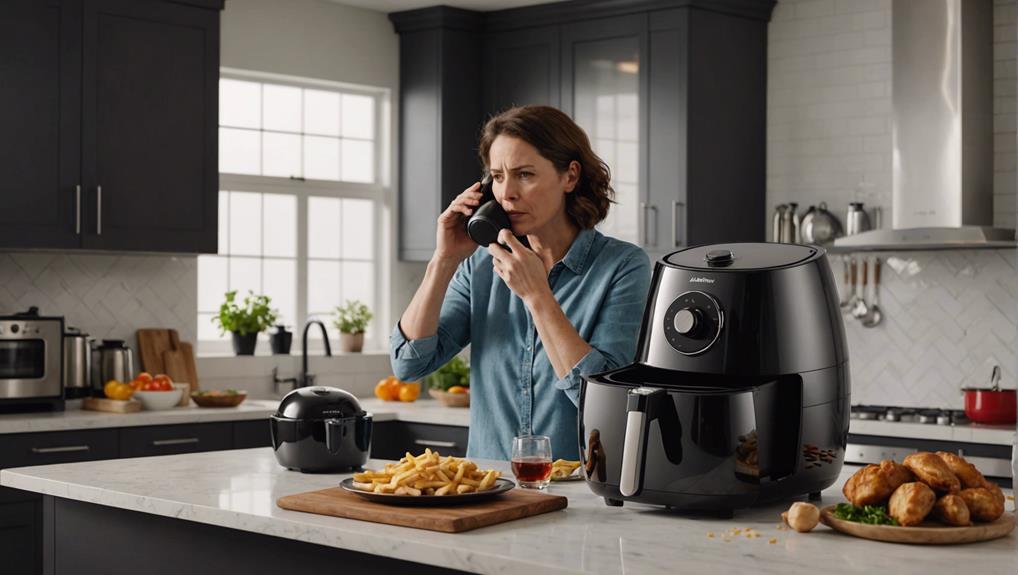
Operating an air fryer often generates noticeable noise due to the fan circulating hot air, which can be particularly disruptive in quiet environments. The fan noise, a byproduct of the convection mechanism that makes air fryers effective, can be louder than traditional cooking methods. This high noise level can be an unexpected drawback if you're accustomed to quieter kitchen appliances.
Different air fryer models exhibit varying degrees of fan noise. Some units are engineered to be quieter but may still be audible enough to cause a disturbance in a serene setting. If you're sensitive to noise or live in a small apartment, the constant hum and occasional rattle could be quite annoying.
The disruptive nature of fan noise doesn't just impact your ears; it can also affect the overall cooking experience. You might find it difficult to hold a conversation or enjoy background music while your air fryer is in operation. For some, this constant background noise can detract from the enjoyment of cooking, making it less appealing to use the appliance frequently.
When considering an air fryer, it's essential to account for the potential impact of noise levels on your cooking environment and daily routine.
Learning Curve
Mastering the use of an air fryer demands a substantial investment of time and practice to achieve the best cooking results. The learning curve is steep, requiring you to become adept at various cooking techniques and timings. Unlike traditional cooking methods, an air fryer's quick cooking process can be challenging to navigate, especially for beginners. Achieving the desired textures and doneness often proves difficult without prior experience.
Understanding the intricacies of appliance operation is important for overcoming this learning curve. Familiarizing yourself with settings, temperature adjustments, and basket arrangements will greatly impact your cooking outcomes. In the beginning, you might find it frustrating to perfect air frying methods for different foods. For instance, foods that require uniform cooking might come out unevenly cooked if timings are not correctly set.
Proficiency in using an air fryer doesn't come overnight; it develops gradually through consistent practice and recipe exploration. Experimenting with different recipes allows you to understand how the appliance responds to various ingredients and cooking styles. As you gain more experience, you'll be better equipped to manage the quick cooking process and achieve the textures and flavors you desire.
Frequently Asked Questions
What Are the Negative Effects of an Air Fryer?
When using an air fryer, you're likely to encounter nutrient degradation, uneven cooking, and limited capacity. They can also produce high noise, potential hazards, plastic smells, and oil splatters, with expensive repairs adding to the drawbacks.
Why Are People Getting Rid of Air Fryers?
You're getting rid of air fryers because of limited capacity for larger meals, counter space usage, cooking noise, and the learning curve. Additionally, health misconceptions, food texture issues, cooking smell, and cleaning hassles contribute to dissatisfaction.
What Cannot Be Cooked in an Air Fryer?
You're dreaming if you think air fryers can handle everything. Forget about battered foods, wet batters, leafy greens, delicate fish, and saucy foods. Rice dishes? Toasted sandwiches? Nope. Cheese dishes? Prepare for a mess.
What Do I Wish I Knew Before I Get an Air Fryer?
Before getting an air fryer, you should know about size limitations, cleaning difficulties, the learning curve, limited capacity, noise levels, space requirements, cost concerns, and potential hazards. These factors can profoundly impact your overall experience and satisfaction.
Conclusion
To sum up, while air fryers offer a convenient cooking method, they come with trade-offs. You'll find their limited capacity and potential nutrient loss frustrating. The risk of acrylamide formation and uneven taste can leave you feeling like you're walking on a tightrope. Additionally, the high noise levels and learning curve might make you reconsider their practicality. Weigh these disadvantages carefully to determine if an air fryer truly fits your culinary needs.
Disclosure: As an Amazon Associate, I earn from qualifying purchases.
